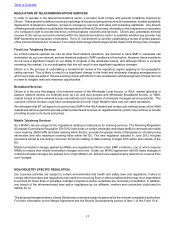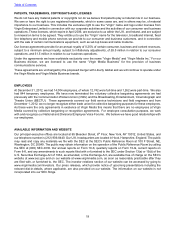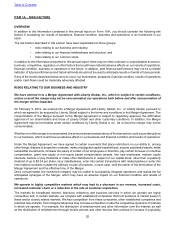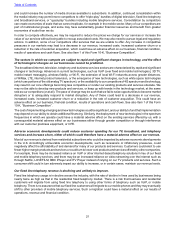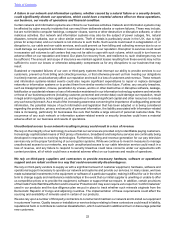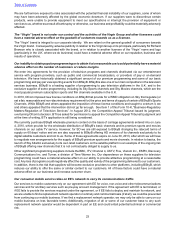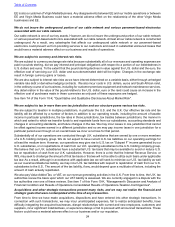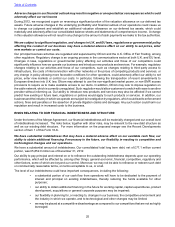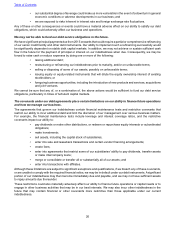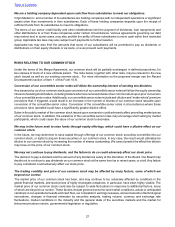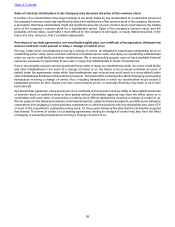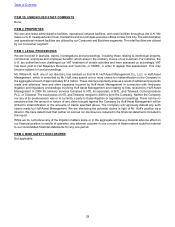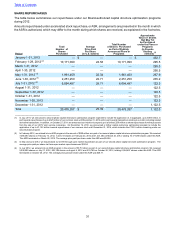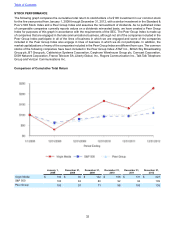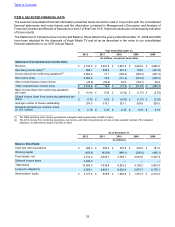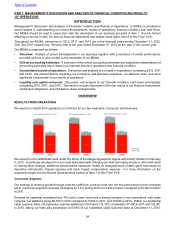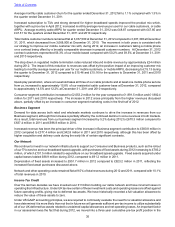Virgin Media 2012 Annual Report Download - page 27
Download and view the complete annual report
Please find page 27 of the 2012 Virgin Media annual report below. You can navigate through the pages in the report by either clicking on the pages listed below, or by using the keyword search tool below to find specific information within the annual report.
26
• our substantial degree of leverage could make us more vulnerable in the event of a downturn in general
economic conditions or adverse developments in our business; and
• we are exposed to risks inherent in interest rate and foreign exchange rate fluctuations.
Any of these or other consequences or events could have a material adverse effect on our ability to satisfy our debt
obligations, which could adversely affect our business and operations.
We may not be able to fund our debt service obligations in the future.
We have significant principal payments due from 2015 onwards that could require a partial or comprehensive refinancing
of our senior credit facility and other debt instruments. Our ability to implement such a refinancing successfully would
be significantly dependent on stable debt capital markets. In addition, we may not achieve or sustain sufficient cash
flow in the future for the payment of principal or interest on our indebtedness when due. Consequently, we may be
forced to raise cash or reduce expenses by doing one or more of the following:
• raising additional debt;
• restructuring or refinancing our indebtedness prior to maturity, and/or on unfavorable terms;
• selling or disposing of some of our assets, possibly on unfavorable terms;
• issuing equity or equity-related instruments that will dilute the equity ownership interest of existing
stockholders; or
• foregoing business opportunities, including the introduction of new products and services, acquisitions
and joint ventures.
We cannot be sure that any of, or a combination of, the above actions would be sufficient to fund our debt service
obligations, particularly in times of turbulent capital markets.
The covenants under our debt agreements place certain limitations on our ability to finance future operations
and how we manage our business.
The agreements that govern our indebtedness contain financial maintenance tests and restrictive covenants that
restrict our ability to incur additional debt and limit the discretion of our management over various business matters.
For example, the financial maintenance tests include leverage and interest coverage ratios, and the restrictive
covenants impact our ability to:
• pay dividends or make other distributions, or redeem or repurchase equity interests or subordinated
obligations;
• make investments;
• sell assets, including the capital stock of subsidiaries;
• enter into sale and leaseback transactions and certain vendor financing arrangements;
• create liens;
• enter into agreements that restrict some of our subsidiaries' ability to pay dividends, transfer assets
or make intercompany loans;
• merge or consolidate or transfer all or substantially all of our assets; and
• enter into transactions with affiliates.
Although these limitations are subject to significant exceptions and qualifications, if we breach any of these covenants,
or are unable to comply with the required financial ratios, we may be in default under our debt instruments. A significant
portion of our indebtedness may then become immediately due and payable, and we may not have sufficient assets
to repay amounts due thereunder.
These restrictions could also materially adversely affect our ability to finance future operations or capital needs or to
engage in other business activities that may be in our best interests. We may also incur other indebtedness in the
future that may contain financial or other covenants more restrictive than those applicable under our current
indebtedness.
Table of Contents



